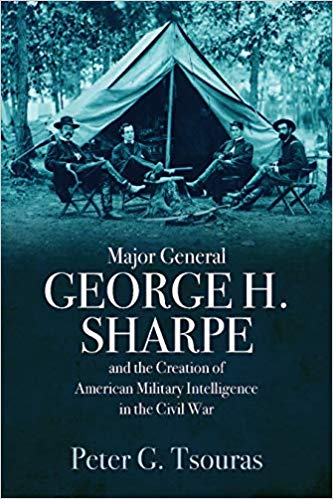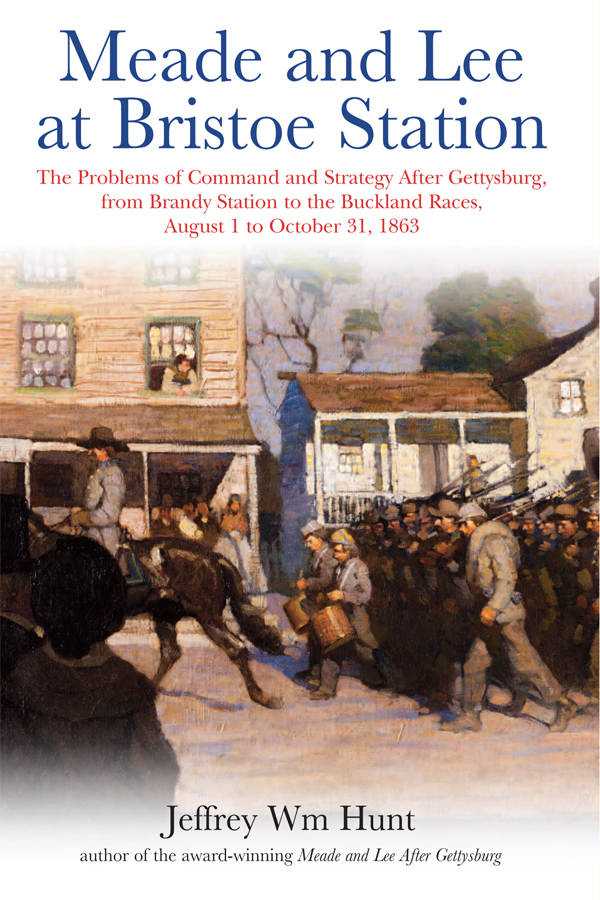Major General George H. Sharpe and the Creation of American Military Intelligence in the Civil War by Peter G. Tsouras. Casemate, 2018. Cloth, ISBN: 978-1-61200-647-5. $34.95.
 The literature on Civil War field army staffs is slim compared with the steady procession of tomes on famous units, battle actions, and key commanders in blue and gray. Perhaps that relative dearth of coverage stems from the fact that mid-nineteenth century American armies themselves operated with miniscule, largely anonymous staffs. Even the term “staff” could be malleable, with personal couriers and aides-de-camp often fulfilling “general staff” roles for which they had little professional training. Peter Tsouras’ work on George H. Sharpe, intelligence-officer extraordinaire of the Army of the Potomac, resurrects the career of perhaps the Civil War’s most consequential staff officer. In Sharpe’s story, readers will find a precursor to modern military intelligence—one that influenced decision-making at crucial moments in the Civil War’s Eastern Theater and may have proved a deciding factor in Union success.
The literature on Civil War field army staffs is slim compared with the steady procession of tomes on famous units, battle actions, and key commanders in blue and gray. Perhaps that relative dearth of coverage stems from the fact that mid-nineteenth century American armies themselves operated with miniscule, largely anonymous staffs. Even the term “staff” could be malleable, with personal couriers and aides-de-camp often fulfilling “general staff” roles for which they had little professional training. Peter Tsouras’ work on George H. Sharpe, intelligence-officer extraordinaire of the Army of the Potomac, resurrects the career of perhaps the Civil War’s most consequential staff officer. In Sharpe’s story, readers will find a precursor to modern military intelligence—one that influenced decision-making at crucial moments in the Civil War’s Eastern Theater and may have proved a deciding factor in Union success.
Tsouras follows New York officer George Sharpe through the fits and starts of crafting the Army of the Potomac Bureau of Military Information, a small information-gathering and intelligence-processing office that proved indispensable to Union operations from 1863 to 1865. Sharpe, a prewar lawyer and self-taught soldier, possessed the acumen and organizational skills necessary to forge a first-class team of scouts, agents, and analysts who could engage the civilian population, interrogate prisoners and escaped slaves, and masterfully conduct what military professionals today call intelligence preparation of the battlefield (IPB). Using a staggering number of official and unofficial sources, the author reconstructs the career of each prominent BMI member in greater detail than any previous historian. As a result, readers get to know these men and appreciate their tremendous effect in shaping the storied battles of the Army of the Potomac.
Central to Sharpe’s rise, as Tsouras skillfully dissects, was the officer’s close relationship with Maj. Gen. Joseph Hooker, the early 1863 Army of the Potomac commander and relentless reformer of that troubled force. Hooker and Sharpe were politically-kindred spirits, both “hard war” pro-Republican officers who could trace their influence in the army back to political patronage. At the height of the army’s revulsion to the growing Copperhead threat, for instance, Sharpe pushed Hooker to limit newspaper access to the camps and make an example of the staunchly Democratic New York Herald. While Sharpe brought a volunteer’s enthusiasm to the job, his fellow New Yorker and general staff officer Marsena Patrick balanced the equation with a demand for hard-nosed administrative discipline. Tsouras repeatedly emphasizes this human dimension of the army staff, especially as it related to Union policy toward civilians and BMI infiltration of the Southern population.
Although readers will find a full treatment of the Army of the Potomac story through Sharpe’s eyes, Tsouras clearly finds BMI actions at the Battle of Gettysburg the most consequential. In what the author calls “one of the important intelligence reports in U.S. military history,” Sharpe provided Maj. Gen. George G. Meade on the battle’s second evening with a full accounting of Confederate prisoners that included every division in Robert E. Lee’s Army of Northern Virginia except George E. Pickett’s. Coupled with the timely arrival of operational and strategic-level insight from rebel documents captured by Capt. Ulric Dahlgren, the result was a clearer picture of the enemy’s situation than any Army of the Potomac commander likely had ever enjoyed—including George B. McClellan, recipient of the famous “Lost Order” in the Maryland Campaign. Unfortunately, the fruits of such an intelligence coup never really blossomed. The Army of the Potomac repulsed Pickett’s Charge the following afternoon, but a week of foul weather, a pervasive suspicion of meddling from Washington, and perhaps Meade’s own reluctance to gamble away his Gettysburg success converged to enable Lee’s escape. On the question of Sharpe’s relationship with Meade, Tsouras wisely devotes considerable attention to the famous July 2 council of war at Gettysburg; it would have strengthened the author’s discussion to delve more deeply into the July 12 council that convinced Meade not to attack Lee’s lines on the Potomac River.
As with so many books on wartime intelligence, Tsouras’ volume occasionally glitters with clandestine characters and derring-do. No episode better contrasts with the drudgery at BMI headquarters than the Dahlgren raid of early 1864, a rather harebrained scheme aimed at striking into Richmond and creating havoc behind the lines. Tsouras details Sharpe’s role in the planning of the affair and notes that its bloody failure deprived the BMI of exceptional talent. Harder, but much more significant, was the work that went into Sharpe’s analysis of Lee’s army during the rapidly-changing environment of mid-to-late 1864. Yet even that story includes contact with an underground espionage ring led by Richmond Unionist Elizabeth Van Lew, the intelligence from which made Sharpe an indispensable asset to Ulysses Grant.
Perhaps the best insight Tsouras provides in this well-written study is his insistence that Sharpe’s benefit to the Army of the Potomac can only be measured by contrasting BMI activity with the abject inefficiency of Lee’s general staff. He contextualizes BMI efforts alongside cavalry reconnaissance and other general staff functions such as the signal and engineer assets. In the process, the author shows how a superior general staff, when coupled with the hard-fighting spirit of the downtrodden Army of the Potomac, helped wrest the initiative away from Lee’s army as the war in the Eastern Theater dragged on.
Zachery Fry is an assistant professor in the Department of Military History, U.S. Army Command and General Staff College, Redstone Arsenal.
